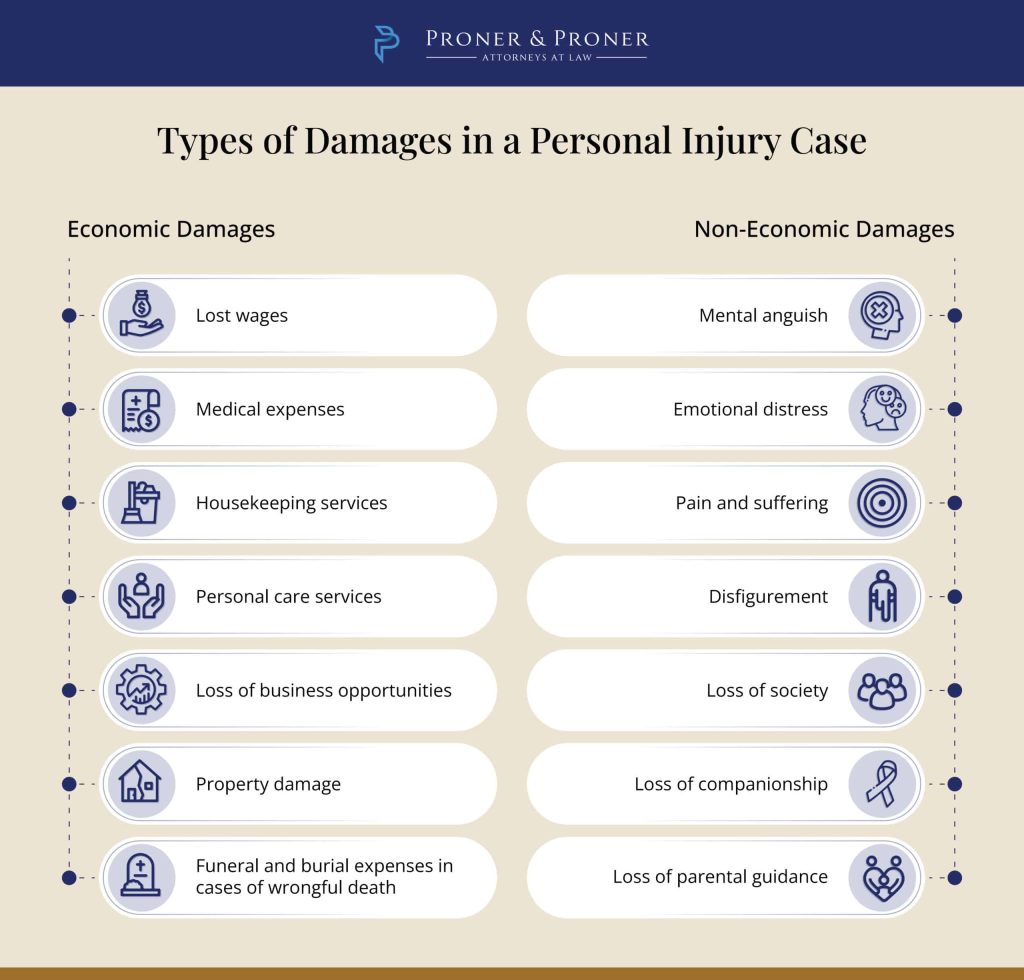- Types of Personal Injury Cases
- How much can a New York City personal injury lawyer help me recover?
- Get Advice From An Experienced Personal Injury Lawyer
- How can a personal injury attorney in NYC help me with my case?
- Is it worth hiring a personal injury attorney?
- Frequently Asked Questions About NYC Personal Injury Claims
- How to Hire a Personal Injury Lawyer
- How to Find a Personal Injury Attorney
- Why is Proner & Proner the best choice for a New York City personal injury lawyer?
According to the New York State Department of Health, injuries claim the lives of 8,000 New Yorkers every year and result in the hospital admission of 155,000 more. Injuries that are caused by the negligence of others are often serious and may result in lifelong consequences.
Proner & Proner has represented personal injury victims for more than 60 years, advocating for the rights of those whose lives have been changed forever. Our New York City personal injury attorneys are sensitive to our clients’ needs while aggressively holding liable parties accountable for their actions.
Our office, located in Midtown Manhattan, serves New York City and the five boroughs with around-the-clock availability. Call us at (212) 500-1003 to speak with a qualified legal professional about your case.
Types of Personal Injury Cases
Personal injury cases most often stem from negligence. Negligence occurs when the following elements can be proven:
- The defendant owed a duty of care.
- The defendant breached the duty of care.
- An injury occurred, which would not have occurred, except for the breach.
- The breach is the proximate cause of injuries.
Wrongful Death
Wrongful death refers to a death that was caused by the negligence or deliberate misconduct of another. Although some cases of wrongful death may result in criminal prosecution, family members are still entitled to file a civil claim on behalf of the decedent. Common causes of wrongful death include the following:
Catastrophic Injuries
Catastrophic injuries are serious injuries that are substantially and permanently disabling. These injuries can also cause severe mental and emotional damage, including post-traumatic stress disorder. They include such injuries as the following:
- Spinal cord injury
- Severe and widespread burn injuries
- Traumatic brain injury
- Amputations
- Organ damage
- Multiple broken bones
- Wrongful death
Related Pages
New York Office
122 E. 42nd St #2015, New York, NY 10168
Email: info@prolaw1.com
Phone: (212) 986-3030
Successful Cases
$6,900,000.00
Female, Male: Premises Liability
$3,500,000.00
Female, 43: Premises Liability
$3,500,000.00
Female, 33: Serious Personal Injury
Testimonials
Got into a motorcycle accident and went to Proner&Proner. I received great services and excellent results, I would definitively recommend the services. It was a great experience for me, A++ attorneys.
– GOOGLE REVIEWER / CLIENT
When I felt I needed legal support after a motorcycle accident, I sought out an attorney who was a motorcyclist as well. Fortunately, I found Mr. Proner. The concern I received was a comfort. The firm’s contact with me while working on my behalf was reassuring and the results certainly made a bad experience easier to put behind me. My gratitude to Proner & Proner.
– GOOGLE REVIEWER / CLIENT
Mitchell Proner is an amazing and very experienced trial lawyer, who takes care of his clients. He represented me in a car accident case, kept me very informed during the lengthy legal process and got me the settlement that I expected. His friendly office staff was always willing to assist and answer any questions I had. I recommend Mitchell Proner to all my friends and family!
– GOOGLE REVIEWER / CLIENT
I am very grateful for the services they were very quick and they dealt with my case right away. Thank you very much.
– GOOGLE REVIEWER / CLIENT
Mitchell Proner is an excellent lawyer. He took our case and did the right thing. We recommend him 100% to anyone. His staff are professionals and they care about their clients.
– GOOGLE REVIEWER / CLIENT
Greatest Lawyers I ever had. Answer any and every question I ever had. They treated me as one of the family. I can’t say enough about this firm. Thank you so much for all you guys did.
– GOOGLE REVIEWER / CLIENT
Awesome experience, excellent service, very professional and fast resolving my case. My number one attorney – definitely recommended more than once. Thank you!
– GOOGLE REVIEWER / CLIENT
What Our Clients Say
Here are some of our clients’ testimonial videos
Slips and Falls
Slips and falls can happen to anyone, but they are especially common among the elderly. These injuries can result in broken hips, spinal cord injuries and head injuries. Property owners, including homeowners, business owners and governments, have a duty to protect guests from slips and falls by removing hazards and providing warnings where hazards exist.
Construction Accidents
New York’s construction industry is especially hazardous for workers. According to the New York Committee for Occupational Safety and Health, 13 New York City construction workers were killed in 2020, down from 24 in 2019, following three years of increases. This accounted for 22 percent of all worker deaths, exceeding the national average.
Motorcycle Accidents
Motorcycle accident cases hold a special interest for Mitchell Proner, the firm’s managing partner. Mr. Proner is an active motorcyclist and advocate for motorcyclist rights with strong ties to the motorcycle community. He was himself severely injured in a motorcycle crash in 1990 and understands the pain and confusion motorcycle accident survivors experience.
Motor Vehicle Accidents
The New York Post reported that 274 people died in traffic fatalities in 2021, reflecting an increase for the third year in a row. Motor vehicle accidents happen in an instant, but the effects can last months, years or even a lifetime. Proner & Proner is experienced with accidents involving a variety of motor vehicle types, including but not limited to the following:
- Car accidents
- Truck accidents
- Commercial vehicle accidents
- Bicycle accidents
- Pedestrian accidents
- Bus accidents
- Train accidents
- Subway accidents
- Taxi accidents
- Uber accidents
- DUI accidents
- Emergency vehicle accidents
Workers’ Compensation Claims
New York workers who experience illnesses or injuries on the job are entitled to receive workers’ compensation benefits, a no-fault system that provides medical care, partial wage replacement and survivors’ benefits to injured employees. To qualify, workers must be employees, not independent contractors, and they cannot be intoxicated when the accident occurs.
Workers’ compensation is limited, and covered employees are not entitled to sue employers for additional damages. However, negligent third parties that cause or contribute to workplace accidents can be held accountable. Third parties that may be liable include:
- Premises owners
- Manufacturers of faulty equipment
- Motor vehicle drivers or owners
Medical Malpractice
Medical malpractice occurs when health care providers fail to exercise a reasonable standard of care and consequently cause injuries. The most common medical errors include the following:
- Failure to diagnose
- Delayed diagnosis
- Misdiagnosis
- Medication errors
- Surgical errors
- Anesthesia errors
Health care providers that can be liable for medical malpractice include doctors, physician assistants, nurses, therapists, pharmacists, hospitals and other medical facilities.
Birth Injuries
Birth injuries often occur as the result of avoidable medical errors. They most frequently occur during complicated births such as when forceps or vacuum extraction must be performed or when a Caesarian section is delayed. The baby may suffer bone fractures from the forceps or oxygen deprivation. Birth injuries can cause mental and emotional anguish to the entire family.
Common birth injuries include the following:
- Cerebral palsy
- Shoulder dystocia
- Seizure disorders
- Facial paralysis
- Brachial plexus
How much can a New York City personal injury lawyer help me recover?
The compensation available is highly specific to the unique details of each case. The types of damages available include verifiable, monetary losses, which are referred to as economic damages, and subjective, non-monetary losses, referred to as non-economic damages.
Economic Damages
- Lost wages
- Medical expenses
- Housekeeping services
- Personal care services
- Loss of business opportunitiesProperty damage
- Funeral and burial expenses in cases of wrongful death
Non-Economic Damages
- Mental anguish
- Emotional distress
- Pain and suffering
- Disfigurement
- Loss of society
- Loss of companionship
- Loss of parental guidance
In addition to these compensatory damages, personal injury victims may be awarded punitive damages, which are meant to punish the defendant for injurious conduct that was deliberate or reckless.

When should I contact an attorney?
New York statutes set specific times frames for when a personal injury action must be filed:
- Most personal injuries: three years
- Medical malpractice: two years and six months
- Wrongful death: two years
Many exceptions exist in statutes of limitations, and a significant amount of work must be completed before a lawsuit can be filed. It is important to involve an attorney in your personal injury case as soon as possible to determine the correct statute of limitations that applies to your case and to allow sufficient time for case development.
Get Advice From An Experienced Personal Injury Lawyer
All You Have To Do Is Call 212-986-3030 To Receive Your Free Case Evaluation.
How can a personal injury attorney in NYC help me with my case?
Filing a personal injury case requires extensive resources, experience and strong knowledge of both medical terminology and the legal system.
Personal Injury Network
An experienced personal injury attorney has a substantial network of resources to help with the following:
- Accident reconstruction
- Forensic analysis
- Medical records retrieval and review
- Expert witness interviews
- Life care planner consultations
These tasks are necessary for establishing fault, proving the case, calculating the lifetime cost of your injuries and negotiating a settlement.
Dealing with Insurance Companies
Most personal injury payouts come from insurance companies. Insurance companies devote extensive resources to minimizing or eliminating compensation. An experienced personal injury attorney can thwart their tactics and negotiate a generous settlement or litigate for a successful verdict on your behalf.
Is it worth hiring a personal injury attorney?
Proner & Proner offers a free case review and works on a contingency basis. You will only owe us legal fees if and when we secure compensation on your behalf. Without an attorney, you risk not receiving any compensation, and even if you do, the compensation we win for you is likely much higher than any amount you could have secured without an attorney. This means you can hire Proner & Proner with nothing to lose and the potential for substantial gain.
What percentage do most personal injury attorneys take?
This varies by the type of case and the amount of work required to secure your compensation, but at Proner & Proner, this amount will always be disclosed to you up front so you can make an informed decision about whether to proceed.
Frequently Asked Questions About NYC Personal Injury Claims
If you or a loved one has been the victim of a personal injury, Proner & Proner can help. Below is a list of common questions about NY personal injury lawsuits that our lawyers are frequently asked.
If you think that you or a loved one may have an injury or wrongful death case, contact our New York personal injury lawyers today to schedule a free case review. If you are the victim of another person’s negligence or carelessness, you may be eligible to file a personal injury lawsuit. You may be able to collect for medical bills, lost wages, permanent injuries, disabilities, punitive damages, or the death of a loved one. In a strong personal injury case, our lawyers must first prove that an injury (not necessarily physical) has occurred. Also, it must be proven that the defendant is responsible for those injuries, through an act of carelessness, negligence, or maliciousness. In the event of a death within the family, surviving family members can file a wrongful death lawsuit.
Many factors determine whether a case can be settled in a matter of months, or will drag on for years. After choosing a competent law firm you must consider the other factors involved such as the client, the insurance company, and the insurance company’s lawyers.
The client affects the duration of a personal injury lawsuit by the length of medical treatment and his or her decision either to settle or to take a risk on a higher recovery resulting from a trial. The length of treatment is important because normally a case should not be settled until the patient has received the maximum benefit of post accident treatment and a long term prognosis for the injury is possible. A doctor must be able to state the extent of the injury’s permanency. As long as a doctor can state the patient’s needs within a reasonable degree of medical certainty, the patient is entitled to money for damages and medical bills for treatment that he or she may need in the future. Therefore, you may be giving up a lot of money that you may need in the future if you settle personal injury lawsuits before a doctor can determine which injuries are permanent. Once a case is settled, it cannot be opened up again.
Whether a case being handled by our New York City personal injury lawyers settles or not is always up to the client. Any offer that is received on a client’s case is always given to the client to accept or reject. We advise the client as to whether the offer is fair, inadequate, or more than the case is worth. We always strive to get our clients more than the case is worth. Since we work for a contingency fee which is a standard percentage of the net settlement, a higher settlement means that more money goes into our clients’ pockets. A fast settlement benefits us as well as our clients, and consequently, we strive to negotiate good settlements as quickly as possible.
Sometimes, however, despite all our arguments, legal motions, correspondence, investigations, and court appearances, the insurance carrier does not offer an adequate amount for settlement. On these occasions our personal injury attorneys are prepared to go to trial. It is always up to the client to choose to go to trial or to accept any amount offered. We are there every step of the way to help our clients make the right decision. Naturally the further along a case goes in litigation, the longer we have to deal with the back log in the courts, and the more time a case will take. Cases that settle without litigation usually do so within six months to a year and a half. With litigation, a case can last approximately two to five years. Larger cases usually take longer. Insurance carriers usually won’t give up hundreds of thousands of dollars without a fight. Also, the insurance companies are allowed to draw interest on the money during the fight so they, unlike us, have it in their best interest to cause a delay. We try everything possible to avoid such delays. Usually, we succeed at getting our clients the money they so greatly deserve and need in a timely manner.
Lastly, the insurance carrier’s lawyers can have a delaying effect on personal injury lawsuits. The lawyers of Proner & Proner in Manhattan have been litigating for more than 40 years and most judges and defense firms know our reputation of excellence. From our New York office, we provide personal injury litigation for victims nationwide. Nonetheless, occasionally other firms will engage in motion practice that will delay a case needlessly. Sometimes even getting a simple order from a judge, will delay a case to our clients’ unfortunate frustration. Fortunately, this is unusual. Normally personal injury lawsuits move quickly to good settlements, keeping our clients satisfied with our practice and the legal system.
Many factors go into determining the value of a case. Although it seems like a simple question, as you are probably aware, it is extremely complex. You should probably avoid a lawyer who will tell you during your first conversation what your case is worth. Such a personal injury attorney could not have possibly given adequate consideration to all of the factors that can drastically change the value of a claim. Of course the two biggest factors are who was at fault for the accident and what the extent of the damage is. Also important is the amount of insurance the defendant has. The following are examples of third party defendants that can be held responsible through personal injury lawsuits: the pizza company that sends out a 16-year-old racing to deliver a pizza in less time than would be considered safe, the municipality that designs an unsafe intersection, the manufacturer of the helmet that doesn’t work, the owner of the bar that served the drunk driver after she was visibly intoxicated, etc. Assuming adequate insurance coverage, there are still additional factors that affect value.
Property damage is usually settled in accordance with agreed published values for the property damaged, reduced by the amount that he/she is at fault for his own loss. If you are 25 percent at fault for an accident, the insurance company may try to offer you 50 percent of the value of your loss. Don’t expect them to pay full value without a lawyer arguing on your behalf.
In personal injury lawsuits, a settlement will be reached if you can agree with the insurance company about what the case is worth. If you can’t agree with the insurance company, one of the personal injury lawyers at our New York law firm can present your case to a jury and judge to determine the value. The insurance companies, in evaluating your claim, will look at your medical bills, length of treatment, frequency of treatment, whether or not there is any permanent disability, whether or not you will need any future treatment, and whether or not you will have any future medical bills. Every detail must be studied so you can get the money you deserve.
Insurance companies will also carefully evaluate your loss of earnings claim. Were you employed at the time of the accident? Did you lose significant time from work? Are you able to return to work at all? Are you highly educated or did you leave school before graduating? If you have less education, you are more likely to find work involving heavy manual labor and injuries. A significant injury will then make it harder to find similar work after an accident increasing your lost earnings.
Your future damages are important. How old are you? If you are in your 30s, you have approximately a 50-year life expectancy. That means you are entitled to claim pain and suffering and loss of earnings for a longer period of time than someone who is 50 with the same permanent personal injury and disability. Another issue is where the claim is being brought. Cases in some courts are known to insurance carriers and personal injury attorneys to get bigger jury awards then other courts. These larger awards can go to higher courts and get reduced on appeal. Nonetheless, the county in which your case is brought can affect the value of the case.
Juries evaluating cases also look at other factors. If you have any convictions for misdemeanors or felonies, or have had previous cases, the jury may doubt your sincerity about this claim. If you were engaged in an activity that jurors think involved unnecessary risk when you got hurt, the jury may give you a smaller award because they feel you should not be rewarded for taking such risks. Skilled personal injury attorneys can minimize unfair reductions in an award by dealing with these matters beginning with jury selection all the way through closing arguments and by reminding jurors of their sworn obligation to give fair compensation.
Lastly, a case’s worth often correlates to how much you are willing to trust your attorney. Most personal injury lawsuits settle. Some cases go to trial. You need to feel confident that your personal injury attorney can achieve the right settlement or decision from a judge or jury; otherwise you may never feel that you obtained what your case is worth.
Victims should not go it alone. It is important to seek an accomplished personal injury attorney. Insurance companies are businesses and, as such, do not have your best interests at heart. The insurance company, as a business, collects as many premiums as possible and pays out as few claims as possible. Insurance companies have teams of experts, lawyers, paralegals, claim adjustors, etc. that are trained to minimize or outright deny your claim. At Proner & Proner, our experienced personal injury lawyers in Manhattan know how to work with—and against—insurance companies and have successfully settled many personal injury lawsuits.
In most situations, victims of personal injury benefit from retaining an attorney. Clients should have someone with experience litigating personal injury lawsuits on their side. Our Manhattan-based firm will deal with the insurance company, your creditors, medical providers, and your employer allowing you to concentrate on getting your health and family back in order.
If you or a family member has been injured and would like to know more about filing personal injury lawsuits, contact the personal injury attorneys at Proner & Proner for a case evaluation. Our personal injury attorneys handle lawsuits throughout the nation.
Punitive damages, also known as exemplary damages, are awarded to a plaintiff in a personal injury lawsuit that arises from “malicious or wanton misconduct” by a defendant. Punitive damages are awarded separately and in excess to compensatory damages (such as lost wages, medical bills, etc.) and are meant to be a punishment for the defendant.
The potential amount awarded for punitive damages is unpredictable and the process of determining punitive damages is arbitrary. The jury alone determines the amount and there are no maximums and no minimums. Often juries act emotionally when ruling these types of personal injury lawsuits. The Manhattan, New York personal injury lawyers of Proner & Proner may seek punitive damages for their clients in instances of malicious misconduct.
Keep in mind that punitive damages differ from state to state. Some states permit insurance for punitive awards while others prohibit insurance on the basis that insuring these damages would be against public policy, believing that punishment should not be transferable. Some states are undetermined on the issue.
Our attorneys at Proner & Proner provide nationwide personal injury representation and can help explain the laws that govern personal injury lawsuits in New York or in your area. We are experienced in personal injury lawsuits and are familiar with the various punitive damages laws.
How to Hire a Personal Injury Lawyer
At Proner & Proner, we make the hiring process easy. Simply schedule a free case evaluation. We will review the merits of your case and walk you through the remaining steps. It is important that we get started on your case as soon as possible to beat the statute of limitations. Contact us today to schedule a free consultation.
How to Find a Personal Injury Attorney
Proner & Proner serves all five boroughs and the Nassau/Suffolk County area:
Proner & Proner Attorneys at Law is located on the corner of East 42nd Street and Lexington Avenue in Midtown Manhattan at 122 E. 42nd St., Suite 2015 in the Chanin Building. The Chanin Building connects to Grand Central Station and is directly across the street from the Chrysler Building. It is within walking distance of Bryant Park and the New York Public Library.


Why is Proner & Proner the best choice for a New York City personal injury lawyer?
Proner & Proner has been advocating for personal injury victims for more than 60 years and has secured millions of dollars in compensation for injury victims. Mitchell Proner has earned the respect of the legal community because of his outstanding result for clients. He has appeared on the following networks to share his legal expertise:
- Car accidents
- Truck accidents
- Commercial vehicle accidents
- Bicycle accidents
- Pedestrian accidents
- Bus accidents
- Train accidents
- Subway accidents
- Taxi accidents
- Uber accidents
- DUI accidents
- Emergency vehicle accidents
Mr. Proner represents his clients with empathy and compassion because, as a motorcycle accident survivor, he understands how it feels to be seriously injured because of someone else’s negligence. Below are just a few of the client testimonials he has received:
In The Press



Office Location
Even though the firm has successfully represented clients from five continents and over 30 jurisdictions, Proner & Proner serves New York personal injury clients in all five boroughs from our office in Midtown Manhattan.

